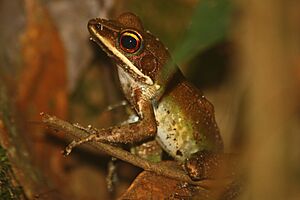Amnirana albolabris facts for kids
Quick facts for kids Amnirana albolabris |
|
|---|---|
 |
|
| Conservation status | |
| Scientific classification | |
| Synonyms | |
|
The Amnirana albolabris is a type of frog that belongs to the Ranidae family. People often call it the white-lipped frog or the forest white-lipped frog. This frog lives in many parts of Sub-Saharan Africa, especially in West Africa and Middle Africa.
Scientists believe there might be different kinds of white-lipped frogs. They are still studying them to see if some should be named as new species.
Where the White-Lipped Frog Lives
The white-lipped frog can be found across a large area of Africa. In West Africa, it lives in countries like Guinea, Sierra Leone, Liberia, Ivory Coast, Ghana, Togo, and Nigeria.
In Middle Africa, you can find it in Cameroon, the Central African Republic, Equatorial Guinea, Gabon, the Republic of the Congo, Angola, the Democratic Republic of the Congo, Uganda, Tanzania, Rwanda, Burundi, and Kenya. There seems to be a small gap in its home range between western Togo and western Nigeria.
What the White-Lipped Frog Looks Like
Female white-lipped frogs are usually about 6.1 to 7.4 centimeters (2.4 to 2.9 inches) long from their snout to their bottom. They have a slightly rounded snout and eyes that stick out.
You can see their eardrum, called the tympanum. Their fingers do not have webbing, but their toes do. This helps them move around in their watery homes.
Home and Habits of the White-Lipped Frog
The white-lipped frog lives in many different places. It can be found in forests that have grown back after being cut down. It also lives in areas where forests have been heavily changed by people. You can even find them in forests along rivers in humid savanna areas.
In West Africa, these frogs live in dense forests and other changed areas. However, in Central Africa, they tend to avoid very thick forests. They are usually found low down in plants and bushes.
These frogs need water to lay their eggs. In West Africa, they breed in large temporary ponds and in permanent streams. In Central Africa, they use still-water ponds, marshes, and even raphia swamps and small creeks.
This frog is very common and can adapt to many different environments. This means it is not likely to be in danger of disappearing, except in very small areas. It also lives in many protected areas, which helps keep its populations safe.


